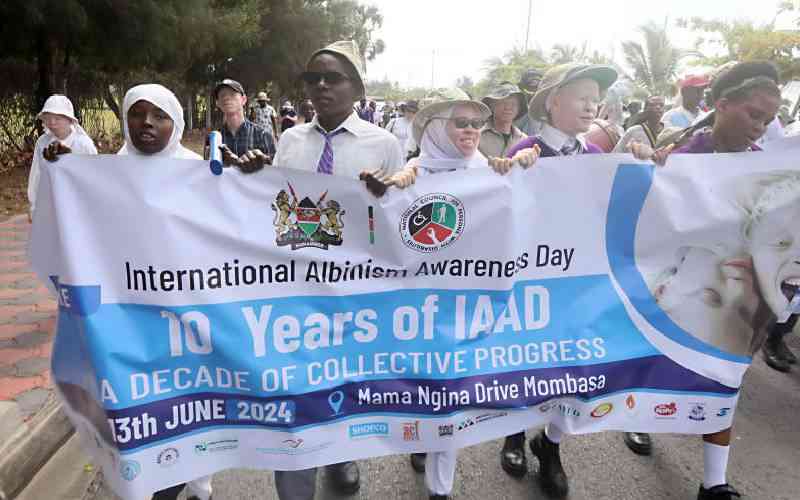Albinism is a genetically inherited condition present at birth which results in the lack of melanin - a chemical responsible for the colour of the skin, eyes and hair.
In almost all types of albinism, both parents must carry the gene for it to be passed on, even if they do not have albinism themselves. The condition is found in both genders, regardless of ethnicity and in all countries of the world. As a result, almost all people with albinism are visually impaired and are prone to developing skin cancer. There is no cure for the absence of melanin.
Persons living with albinism are classified as persons with disability due to the visual impairments associated with their condition. Article 54 (1) (a) of the Constitution of Kenya 2010 provides that a person with any disability is entitled to be treated with dignity and respect and to be addressed and referred to in a manner that is not demeaning. This provision therefore extends to persons with albinism.
In some communities, erroneous beliefs and myths influenced by superstition put the security and life of people with albinism at risk. These beliefs and myths are centuries old and are present in cultural attitudes and practices around the world. Lack of sound knowledge on the condition has led to discrimination and stigma.
These myths include that albinism is contagious; that having sexual intercourse with a woman or girl with albinism can cure HIV/Aids; that sacrifice of people with albinism can appease gods; that pulling out the hair of a person with albinism brings good luck; or that the body parts of people with albinism can be used as sacrifices to bring prosperity. Other myths include that people with albinism are cursed or that they are super human and do not die but simply vanish.
All these beliefs are erroneous and ignorant. The danger lies in the fact that they lead to ritual attacks, trafficking in persons, abandonment of children and widespread discrimination of people with albinism. There is need for greater state protection because these myths have led to the death and maiming of many persons with albinism in East Africa especially Kenya, Tanzania, Burundi and Congo.
In Tanzania, the use of albino body parts, especially arms, fingers or legs, in the making of charms is widespread. Witch doctors sell the charms to their clients promising them wealth or luck in elections, in business and life generally.
The demand for albino body parts is, unfortunately, a lucrative business. According to the United Nations, body parts sell for around $600 in Tanzania, with an entire corpse fetching $75,000.
During elections, the hunt for albino body parts usually rises in Tanzania, as political candidates look for lucky charms to get them elected to various elective posts. This year’s elections have not been any different. This is but one of the many cases of ritual attacks by gangs of albino hunters operating in intricate networks to satisfy the high demand of body parts of people with albinism.
These networks are not confined to Tanzania with gangs of albino hunters crossing the border to Kenya to perpetuate further attacks. As the state endeavours to implement the Constitution of Kenya, 2010, it is imperative that greater protection is afforded to people with albinism as they deserve to be treated with human dignity and respect, to be free from discrimination and to benefit from affirmative action.
As persons with disability, they deserve to have their human rights safeguarded including their rights to life and security, their right not to be subject to torture and ill-treatment, and to ensure their access to adequate health care, employment, education and justice.
Steps that can be taken towards fully realising their rights include intensifying public education on albinism as a way of reducing the discrimination and stigma; hiring of persons with disabilities which extends to people with albinism; increasing initiatives to prevent early deaths due to cancer and providing low-cost visual aids.
There is also a need to conduct more research on the link between science and the law as the attacks on people with albinism are a reflection of the failure of science to make inroads into the sphere of culture and belief practices and ultimately the failure of science to influence state law enforcement priorities.
 The Standard Group Plc is a
multi-media organization with investments in media platforms spanning newspaper
print operations, television, radio broadcasting, digital and online services. The
Standard Group is recognized as a leading multi-media house in Kenya with a key
influence in matters of national and international interest.
The Standard Group Plc is a
multi-media organization with investments in media platforms spanning newspaper
print operations, television, radio broadcasting, digital and online services. The
Standard Group is recognized as a leading multi-media house in Kenya with a key
influence in matters of national and international interest.
 The Standard Group Plc is a
multi-media organization with investments in media platforms spanning newspaper
print operations, television, radio broadcasting, digital and online services. The
Standard Group is recognized as a leading multi-media house in Kenya with a key
influence in matters of national and international interest.
The Standard Group Plc is a
multi-media organization with investments in media platforms spanning newspaper
print operations, television, radio broadcasting, digital and online services. The
Standard Group is recognized as a leading multi-media house in Kenya with a key
influence in matters of national and international interest.








